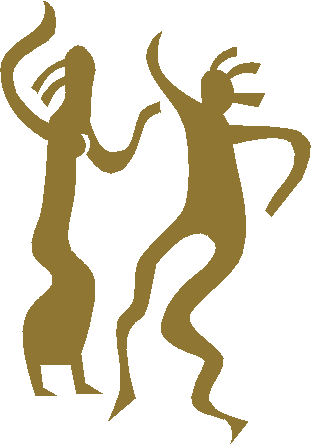| PARTNER
CONNECTION  I
must admit that while partner connection is already extremely difficult to explain,
demonstrate and acquire in actual dance classes, it is a hundred times more
difficult to simply explain in words. But we will still try, together with the help of
some dance friends. There is much information about this topic in Mark Balzer's FAQ list on Lead and Follow.
So please make sure to link up for a better understanding. I
must admit that while partner connection is already extremely difficult to explain,
demonstrate and acquire in actual dance classes, it is a hundred times more
difficult to simply explain in words. But we will still try, together with the help of
some dance friends. There is much information about this topic in Mark Balzer's FAQ list on Lead and Follow.
So please make sure to link up for a better understanding.
Partner connection involves and
requires among others good hand and arm tone, dance frame, and posture, as well as a
working understanding of the dynamics of body movement, weight changes, individual
balancing and common centering, force level leading and following techniques.
In the Philippines, those teachers and dance
instructors who have enough patience and knowledge to teach lead/follow to their students
and guests have referred to these as simply leads, and more specifically as
chest leads, arm leads, and hand leads. As far as I understand,
these are all conditions, signals and signs which a dancer uses to communicate with the
partner. Lest I just repeat what other have already said, please consider the following
links to other sites.
POSTURE
Generally, dances require an erect yet relaxed body posture from both the
leader and the follower. The key word is relaxed. However, several dancers change the
overall look and line of the couple with a slight forward bend, such as in East Coast
Swing (Boogie). More insights from FAQ on Posture.
WEIGHT CHANGES
A weight change simple means
the positioning of the dancer's Center Point of Balance (CPB)
over one of either foot. It is definitely not a point, or tap. The body weight is
transferred firmly on the center of the foot, precisely on that area below the toe and
beside the ball of the foot. Once the CPB is precisely on top of this point, the dancer
will know he has actually stepped on that foot and is totally balanced. Check out FAQ on Weight Changes.
DANCE FRAME
A well-toned dance frame,
balanced and stable, firm and solid, is a result of good posture and is the key
element which enables the dancing couple to move around a common center. It also helps the
partners to be concentrate on the lead/follow signals and messages instead of the other
unnecessary body movements (noise). A more detailed discussion is available from the FAQ list on Dance Frame.
BODY LEADS
We're said it several times before. All leads
emanate from the body, thus you hear of teachers referring to body leads. Even if the only physical connection
between you and your partner is through the hands, the source of the lead is still
the body. To be more precise, the source is the solar plexus, or the
diaphragm, that
small round muscle at the bottom of the ribs. In dancing, this is known as the
Center Point of Balance or CPB. The chest, arms, hand and
fingers, are mere extensions of the body, through which the lead is coursed. Because of
this, the partners should always maintain a clear and sensitive connection with each
other, so that each lead can easily be read by the follower, and the follower can react on
the intended time with the intended step and position in the intended direction. See FAQ on Body Leads.
ARM TONE
Arm tone, is the amount of force or pressure used by the dancer's arm to
send and receive messages and signals to and from a partner while dancing. Firm, but not
forceful, tension is most appropriate. Various dance movements and positions will require
a variety of pressure levels; and so does dancing with various partners. Some partners are
not yet sensitive enough to subtle leads, and require stronger arm tension to they can
feel the connection. Over time however, they will learn to tone these down as their
sensitivity heightens. See also FAQs on Arm Tone and
Shoulder and Arm Leads.
HAND TONE
Hand tone is the level of force or pressure of the hand and fingers which
a dancer (leader or follower) uses to send and receive messages to and from a partner
while dancing. The rule my partner and I use is simple: firm yet flexible. The hold should
not be a grip but a relaxed touch. So why the lady's hand may be in the man's hand,
neither hand grips the other. With the lady holding her own arm's weight, her hand would
be comfortable light in his hand. The same hold applies to her left hand on his shoulder
or upper arm, and his right hand on her back. The hold allows from the flexibility
required for turns and changes in dance positions of the partners. See also FAQs on Hand Tone and
Hand and Finger Leads.
FORCE LEVEL
This simply means that the
leader should not use too much force -- like pushing, pulling and hauling -- nor too
little force as to be indistinguishable from a touch when leading the partner. Dancing is
meant to be pleasurable, not the cause of sprains and bruises, and worse quarrels and
fights. A better discussion is available from FAQ on Force Level and
FAQ on why Forceful
Leads are not Required.
A much more extensive discussion
on partner connection may be found in Dance FAQs.

|
